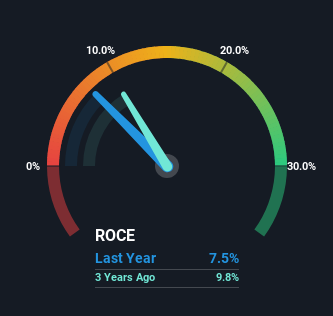Here's What's Concerning About Schneider National's (NYSE:SNDR) Returns On Capital
Finding a business that has the potential to grow substantially is not easy, but it is possible if we look at a few key financial metrics. Typically, we'll want to notice a trend of growing return on capital employed (ROCE) and alongside that, an expanding base of capital employed. Ultimately, this demonstrates that it's a business that is reinvesting profits at increasing rates of return. However, after briefly looking over the numbers, we don't think Schneider National (NYSE:SNDR) has the makings of a multi-bagger going forward, but let's have a look at why that may be.
What Is Return On Capital Employed (ROCE)?
For those that aren't sure what ROCE is, it measures the amount of pre-tax profits a company can generate from the capital employed in its business. Analysts use this formula to calculate it for Schneider National:
Return on Capital Employed = Earnings Before Interest and Tax (EBIT) ÷ (Total Assets - Current Liabilities)
0.075 = US$297m ÷ (US$4.6b - US$606m) (Based on the trailing twelve months to December 2023).
Therefore, Schneider National has an ROCE of 7.5%. On its own that's a low return on capital but it's in line with the industry's average returns of 8.1%.
See our latest analysis for Schneider National
Above you can see how the current ROCE for Schneider National compares to its prior returns on capital, but there's only so much you can tell from the past. If you'd like to see what analysts are forecasting going forward, you should check out our free analyst report for Schneider National .
What Can We Tell From Schneider National's ROCE Trend?
When we looked at the ROCE trend at Schneider National, we didn't gain much confidence. Over the last five years, returns on capital have decreased to 7.5% from 12% five years ago. And considering revenue has dropped while employing more capital, we'd be cautious. If this were to continue, you might be looking at a company that is trying to reinvest for growth but is actually losing market share since sales haven't increased.
Our Take On Schneider National's ROCE
In summary, we're somewhat concerned by Schneider National's diminishing returns on increasing amounts of capital. Despite the concerning underlying trends, the stock has actually gained 30% over the last five years, so it might be that the investors are expecting the trends to reverse. Regardless, we don't like the trends as they are and if they persist, we think you might find better investments elsewhere.
If you'd like to know about the risks facing Schneider National, we've discovered 2 warning signs that you should be aware of.
While Schneider National isn't earning the highest return, check out this free list of companies that are earning high returns on equity with solid balance sheets.
Have feedback on this article? Concerned about the content? Get in touch with us directly. Alternatively, email editorial-team (at) simplywallst.com.
This article by Simply Wall St is general in nature. We provide commentary based on historical data and analyst forecasts only using an unbiased methodology and our articles are not intended to be financial advice. It does not constitute a recommendation to buy or sell any stock, and does not take account of your objectives, or your financial situation. We aim to bring you long-term focused analysis driven by fundamental data. Note that our analysis may not factor in the latest price-sensitive company announcements or qualitative material. Simply Wall St has no position in any stocks mentioned.

